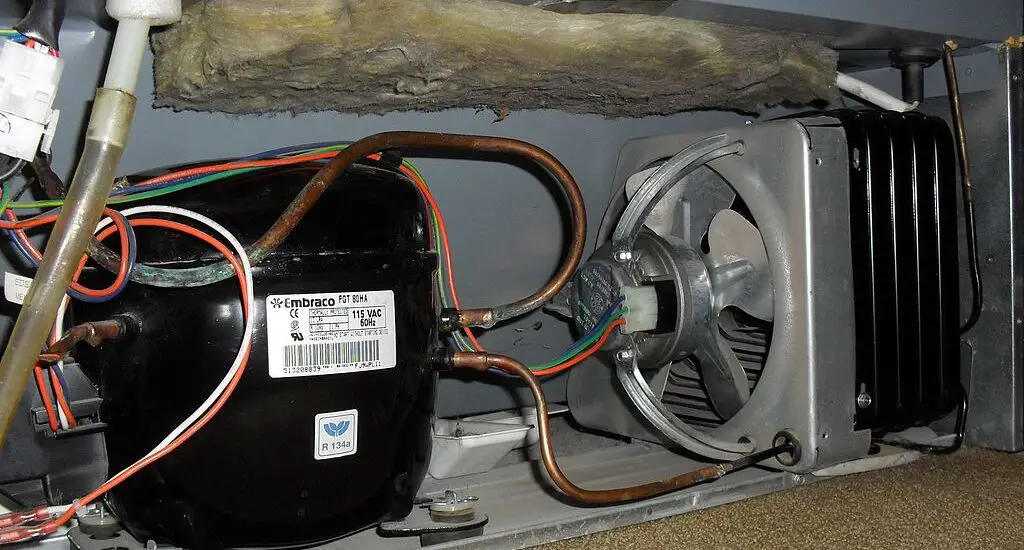In this article, we’re addressing the pressing issue of your ‘refrigerator condenser fan not working’. Stick with us to navigate this tricky terrain and get your refrigerator humming happily again.

Table of Contents
Identifying the Problem
The first step in any problem-solving journey? Pinpointing the problem. Let’s take a look at how you can do that for your refrigerator’s condenser fan.
Symptoms of Refrigerator Condenser Fan Not Working
Is your refrigerator acting like it’s in a sweat lodge instead of a cool, homey kitchen? This could indicate a faulty condenser fan. Other signs may include excessive noise, constant cycling, or the exterior becoming too hot to touch.
Basic Troubleshooting: Is it Really the Condenser Fan?
Before you point fingers at the condenser fan, let’s rule out other culprits. Check for any obvious obstructions, power supply issues, or unusual frost buildup. If these boxes are ticked off and you’re still facing problems, it’s safe to say your condenser fan might be the troublemaker.
Inspecting the Refrigerator Condenser Fan
Alright, time to roll up those sleeves and get a little hands-on. Don’t worry, we’ll guide you through the process of inspecting your refrigerator condenser fan.
Tools Needed for Inspecting the Fan
A multimeter and a flashlight should be enough for this initial inspection. And, of course, you’ll need a Phillips head screwdriver to get to the fan. Remember, being equipped with the right tools is just as important as the right knowledge.
Safety Precautions Before Inspection
Remember, safety first! Make sure to unplug your refrigerator before beginning any inspection or repair. It’s also a good idea to wear protective gloves to avoid any potential scrapes or cuts.
Steps to Inspect the Condenser Fan
Now, let’s get to the heart of the matter. Or rather, the back of your fridge, where the condenser fan resides.
Locating the Condenser Fan
Like a shy musician hiding backstage, your condenser fan is usually found at the back of your fridge, near the bottom, tucked away behind a panel.
Checking for Obvious Issues
Once you’ve located the fan, look for anything glaringly wrong, like debris obstructing the fan blades, or if the blades are broken or loose.
Listening for Unusual Noises
If everything looks good so far, plug in your fridge and listen for any strange noises. A healthy fan is quiet, while a sick one may hum, rattle, or remain ominously silent.
Testing the Fan Motor
If your fan isn’t running smoothly or not running at all, use your multimeter to check if the motor is getting power. If there’s no power, the motor could be faulty, and you might need to replace it.
Check out these other related articles…
AC Condenser Fan Not Spinning: Troubleshooting & Sure Fixes
What Does a Condenser Fan Motor Do in a Refrigerator?
How to Fix Condenser Fan Motor on Fridge: In Easy Steps
Condenser Fan Not Spinning: 6 Proven Solutions
Repairing or Replacing the Condenser Fan
Once you’ve confirmed the culprit is indeed the condenser fan, it’s time to decide whether a repair or replacement is the best course of action.
When to Repair the Condenser Fan
If the issue with the fan seems minor, such as a loose blade or minor obstruction, a simple repair might just do the trick. But remember, if you’re unsure, it’s always better to consult a professional.
When to Replace the Condenser Fan
If your fan is no longer spinning, or it’s making noises even after cleaning and checking for obstructions, it might be time to say goodbye and replace it. But don’t worry, we’re here to guide you through that process as well.
Steps to Replace the Condenser Fan
Replacing the condenser fan is not as daunting as it might sound. Here are the steps you need to follow:
Gather the Necessary Tools and Parts
First things first, gather the necessary tools for the job. You’ll need your trusty screwdriver, a new fan motor, and perhaps a friend for moral support!
Removing the Old Condenser Fan
Once you’ve unplugged your fridge, remove the back panel and then disconnect the fan. Be careful not to yank or damage any attached wires.
Installing the New Condenser Fan
Now, it’s time to put in the new fan. It should fit in the same spot as the old one. Once it’s secured, reconnect any wires you previously disconnected.
Checking the New Installation
After everything’s hooked up, plug your fridge back in and listen. Hear that? It’s the sound of your fridge thanking you with a healthy hum!
Finding a Professional for Repair or Replacement
If all this sounds a tad overwhelming or you’re still not sure what’s causing the problem, it might be time to call in the professionals. Check out local services or your refrigerator manufacturer’s website for repair services.
Maintenance Tips to Prevent Future Issues
Prevention is better than cure, they say. And they’re right. Here are some maintenance tips to keep your refrigerator in top shape.
Regular Cleaning
Just like you, your fridge needs a little TLC from time to time. Regular cleaning, especially of the coils and fan, can help prevent future issues.
Avoiding Overloading the Refrigerator
Ever feel like you just can’t think straight when you’re too stuffed? Your fridge feels the same way. Overloading it can stress the condenser fan, so try to keep your fridge comfortably full, not crammed.
Regular Maintenance Checks
Just as a yearly check-up keeps you healthy, regular maintenance checks keep your fridge humming happily. Check your manual for maintenance tips specific to your refrigerator model.
